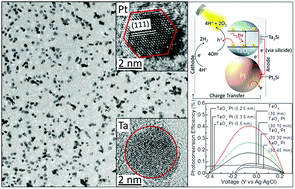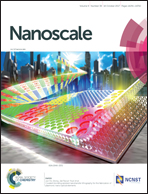Efficient photoelectrochemical water splitting on ultrasmall defect-rich TaOx nanoclusters enhanced by size-selected Pt nanocluster promoters†
Abstract
Formation of nanoclusters has attracted a lot of attention in recent years because of their distinct properties from isolated atoms and bulk solids. Here, we focus on the catalytic properties of supported transition metal oxide nanoclusters, such as TaO2, with a well-defined size distribution below 10 nm. We show that their catalytic performance can be greatly enhanced by introducing a reaction promoter such as Pt. Different combinations of precisely size-selected, defect-rich TaOx and Pt nanoclusters are produced by a gas-phase aggregation technique in a special DC magnetron sputtering system. Argon flow rate and aggregation length are carefully optimized to control the sizes of these ultrasmall TaOx and Pt nanoclusters by using a quadrupole mass filter, and TEM studies reveal the different crystalline nature of TaOx (amorphous) and Pt (crystalline) nanoclusters. We have further demonstrated the size-dependent photoanode activity of (TaOx, Pt) nanocluster systems in a photoelectrochemical water splitting reaction, where the Pt nanocluster promoters are found to provide a significant enhancement in the photocurrent density, approximately tripled that was observed from just TaOx nanocluster catalysts alone. The photocurrent density and photoconversion efficiency tend to reduce when Pt nanoclusters become overpopulated due to blocking of the photosensitive TaOx surface. Reducing the Pt nanocluster size resolves this problem by incorporating a greater number of smaller nanocluster promoters without blocking TaOx, which leads to further enhancement in the photocurrent density. The enhanced photocatalytic activity is attributed to synergetic effects introduced by the Pt nanoclusters that act as temporary charge storage sites to facilitate effective separation of a large number of electron–hole pairs, generated from a large number of active sites on the defect-rich amorphous TaOx nanoclusters upon illumination.



 Please wait while we load your content...
Please wait while we load your content...